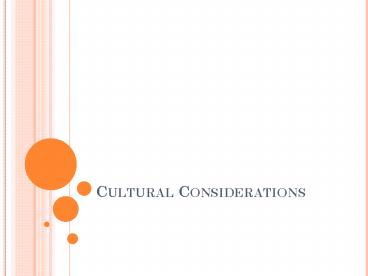Cultural Considerations - PowerPoint PPT Presentation
1 / 16
Title:
Cultural Considerations
Description:
CULTURAL CONSIDERATIONS WHAT IS CULTURE? How does one identify as part of a culture? How does one identify that someone is from a culture different than one s own? – PowerPoint PPT presentation
Number of Views:739
Avg rating:3.0/5.0
Title: Cultural Considerations
1
Cultural Considerations
2
(No Transcript)
3
What is Culture?
- How does one identify as part of a culture?
- How does one identify that someone is from a
culture different than ones own? - How do we learn about other cultures?
Gibbons, R.
4
(No Transcript)
5
Housing
Clothing
Food
Music
Primarily in Awareness
Fine arts and crafts
Dance
Literature
Language
Celebrations
Courtship
Conflict resolution
Values
Human rights
Role of the elders
Personal space
Worldview
Kinship patterns
Gender roles
Primarily out of Awareness
Facial expressions
Parenting practices
Status and how it is determined
Concept of beauty
Gibbons, R.
6
Defining Culture
- Shared experiences that develop and evolve
according to changing social and political
landscapes. It includes the following axes of
identification within the historical context of
oppression. - Race
- Ethnicity
- Gender
- Sexual orientation
- Class
- Immigration
- Ability
- Age
- Location
- Time
Warrier, S. (2005).
7
Defining culture
- Neither a blueprint nor an identity
- Complex, multi-faceted
- Always changing
Safe Harbors Youth Intervention Project, 2009
8
Cultural lens
- Consideration of Culture must encompass what we
know about ourselves first, what cultural lens
we bring to the experience. - What has shaped your cultural lens?
9
Cultural sensitivity and cultural competency
- Sensitivity An awareness, understanding,
responsiveness, and respect for the beliefs,
values, customs, and institutions (family,
religious, etc.) of a group of people,
particularly those different from ones own - Competency Incorporating the awareness,
understanding, responsiveness, and respect into
services - Cultural Competency is a life-long learning
process, not an end result
10
How privilege and oppression impact culture
- Privileged group behaviors, values, customs,
language, institutions, etc. are the norm - Cultural Monopoly A single source, view, center
of power which defines, determines and dictates
the cultural norm for process, procedure,
communication and interaction in everyday task
and existence, based on the mainstream social
structure
11
Cycle of Oppression
- No choice who we are
- No Information
- No Misinformation
- No Biases or Stereotypes
- Born into Social Groups
- Know Nothing
- Promote Status Quo
- Inaction is Action
- Pass to Next Generation
- Become part of the Problem
- Guilt/Rage
- Fear/Hurt
- Confusion
- Dehumanization
- Self-Hatred/Defensiveness
- Stress/Lack of Reality
- Hate/Ignorance
- Parents, Teachers
- People we trust
- Our norms, values,
- Roles, and rules are shaped
- Media
- Schools
- Religious Institutions
- Government/Laws
- Privileges/Punishments
- Discrimination
- Empowerment
- Stereotypes
- Myths
- Misinformation
Adapted from Cycle of Oppression, Roberto
Harro, Diversity Works, Amherst MAJ. Jay Scott,
Office of Housing, University of Florida,
Gainsville
12
Breaking the Cycle of Oppression
- Which Calls Us To
- Learn New Information
- Unlearn Misinformation
- Recognize/Analyze Stereotypes
- Move Out of Our Comfort Zone
- Anger, Pride, Love, Empowerment
- Educating Ourselves, Educating Others
- Interrupting Oppression
- Celebrating Diversity
- Building Communities and Coalitions
- Race/Ethnicity
- Gender/Age/Sexual Orientation
- Class/Economic Resources
- Spirituality
- Physical Abilities/Mental/Emotional Abilities
Adapted from Cycle of Oppression, Roberto
Harro, Diversity Works, Amherst MAJ. Jay Scott,
Office of Housing, University of Florida,
Gainsville
13
How do we become culturally competent?
- Become aware of our own cultural values, biases
and assumptions about human behavior - Understand how cultural differences, attitudes
and behaviors are crucial to effective
communication - Always consider Language, Communication Style,
Alternative Learning Styles, Values, Roles,
Traditions and Beliefs - Understand how oppression and privilege impacts
services and survivors
14
Our Core Elements
Awareness Impact of Your Personal Cultural
Lenses on Intervention
YOUR Core Elements
Incorporation and Balance of YOUR Core Elements
with a Commitment of Awareness to Self,
Organization and Community
Importance of Self Awareness and its Contribution
to our worldview
Awareness, Recognition, Knowledge and Proactive
Action in our intervention
Recognition, Commitment, Effective Strategies and
Action to INTERRUPT Culturally Inappropriate/Offen
sive remarks, actions, policies, etc
Awareness of Privilege and Misunderstanding/Misint
erpretation and Strategies to address and avoid
15
Question
- What are some specific ways you could become more
culturally considerate/sensitive/competent?
16
References
- Espondaburu, L. Cultural Considerations
Understanding Culture and its Impact on
Intervention. PowerPoint slides. - Gibbons, R. Cultural Competency in Violence
Prevention and Intervention. PowerPoint slides. - Safe Harbors Youth Intervention Project. (2009).
Cultural Considerations When Working with
Homeless Runaway and Sexually Exploited Youth.
St. Paul, MN Partners for Violence Prevention. - Warrier, S. (2005). Culture Handbook. Retrieved
from http//endabuse.org/userfiles/file/ImmigrantW
omen/Culture20Handbook.pdf






























![Download Book [PDF] Handbook of Cultural Developmental Science PowerPoint PPT Presentation](https://s3.amazonaws.com/images.powershow.com/10051362.th0.jpg?_=20240609104)
